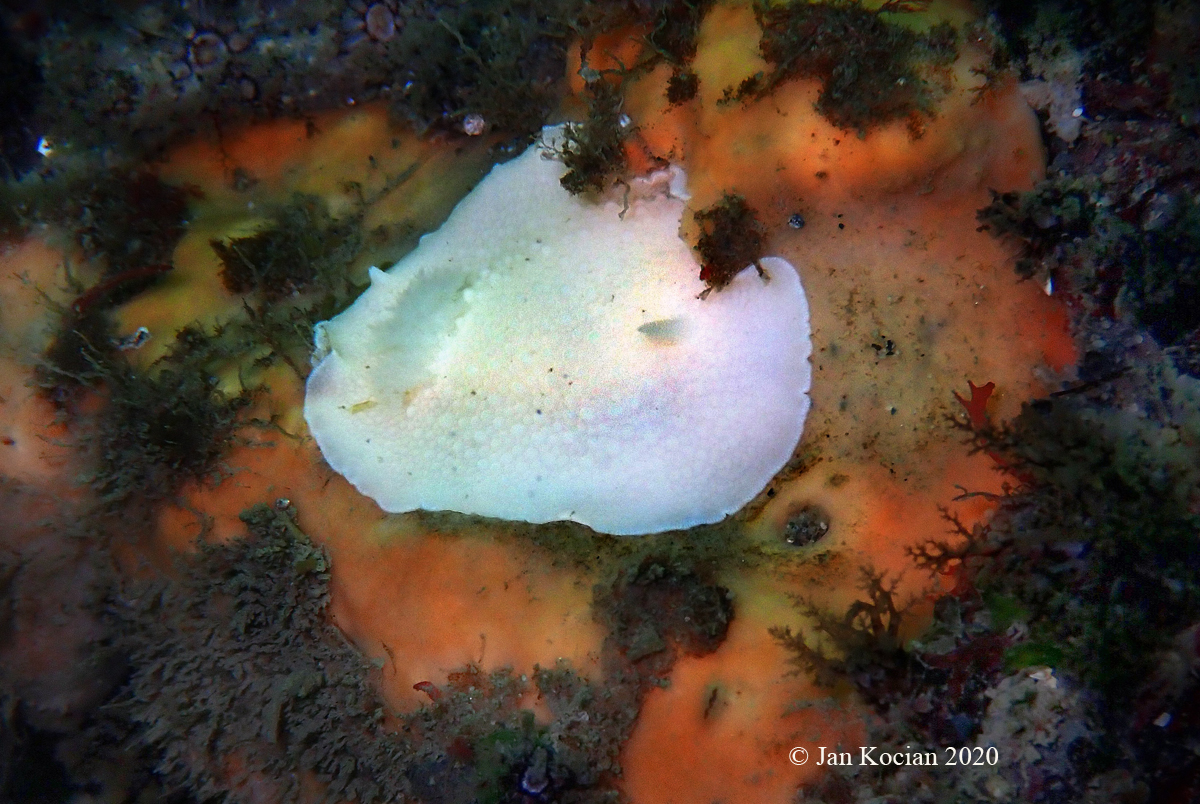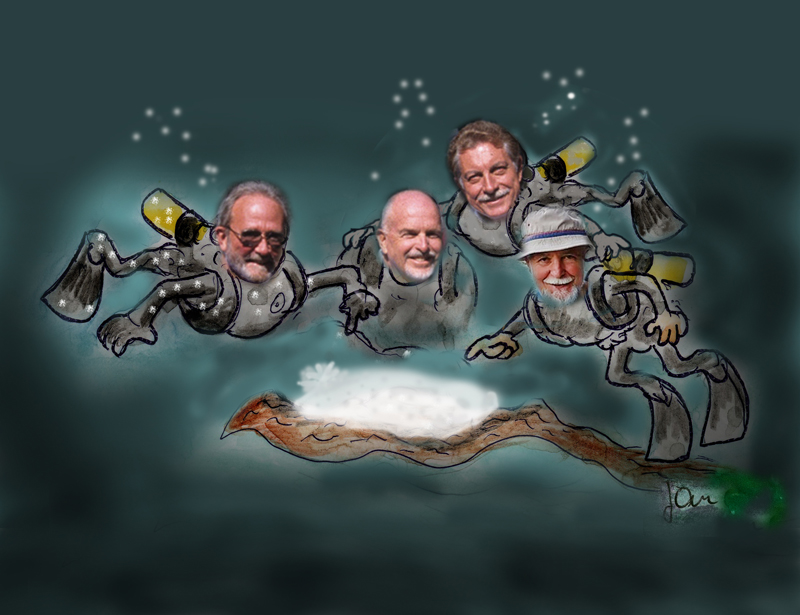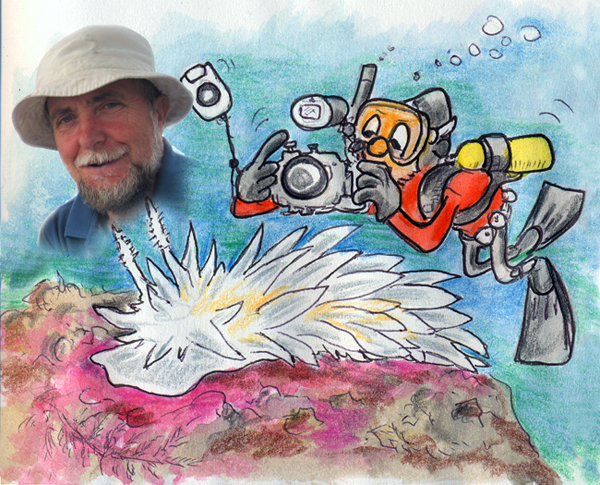 |
Aldisa tara
Photo by Jan Kocian, 15 June 2020
Aldisa tara Millen in Millen & Gosliner, 1985
Rare species can be those with only a few known specimens, or those from a very restricted geographic range. This week’s BOW fits both criteria, even though it occurs along the Pacific coast of North America, one of the most studied nudibranch regions.
The original description was based on 6 type animals, one from Porlier Pass, Galiano Island, British Columbia, Canada (49º 01' N; 123º 36' W), and five from Earl’s Cove, British Columbia (49º 45' N; 124º 01' W), all found between 10-15 meters deep. They also reported its occurrence at Steep Island, Discovery Passage (50º 59' N). Another specimen was reported from Fearnie Bluffs, Agamemnon Channel, British Columbia (49º 43' N’ 124º 3' W) by Marli Wakeling (2006). Just a few days ago, Jan Kocian found and photographed a ~30-mm animal (1)(2)
at Deception Pass, Whidbey Island, Washington, USA (48º 24' 22" N; 122º 38' 42" W), at 8.6 meters deep. All known specimens have been found within about 150 nautical miles of each other, at sites near the Juan de Fuca Straits. Animals have not yet been reported from the western coast of Vancouver Island, nor the outer Pacific shoreline of Washington.
Jan Kocian spotted his Aldisa tara
animal on 12 and 15 June; it had not moved much.
Living individuals range from about 10 to 30 mm. The oval body is depressed, with a
wide mantle covering the head and tail. Dorsum is covered with conical tubercles, with a dense,
interconnecting network of spicules below the surface. The rhinophores are stout, with a short,
conical stalk. The clavus is dilated slightly, perfoliate, with 14-18 leaves. There are 8-11
bipinnate branchiae forming a complete circle. The head, digestive tract and
radula are all typical
of the genus. (Paraphrased from Millen & Gosliner, 1985) Millen & Gosliner report that the spawn of A. tara was observed from May to July; the
upright coil is white, with 1 3/4 whorls. The eggs are planktotrophic. There are apparently 20 valid species of Aldisa worldwide. WoRMS lists 21, but it
erroneously includes Aldisa alabastrina (Cooper, 1863), which Steinberg (1961) long ago
appropriately considered a nomen dubium. Nine unnamed species are reported to occur in the
Indo-Pacific (Gosliner, Valdés & Behrens, 2018). Many of the species are considered mimics
with similar color patterns to several Phyllidia species (e.g., Aldisa albatrossae Elwood, Valdés
& Gosliner, 2000), and many others resemble their prey sponge in coloration and structurally
with dorsal pits resembling the oscula of sponges (e.g., Aldisa pikokai Bertsch & Johnson, 1982).
Aldisa had long been considered a member of the Dorididae, but recent work (Johnson, 2011)
has shown both Aldisa and Cadlina to be more closely related to each other than to their previous
designations as members of the Dorididae and Chromodorididae respectively. Natural history information for most species tends to be scarce, with the notable
exceptions of A. pikokai, A. sanguinea (Cooper, 1863) and A. zetlandica (Alder & Hancock,
1854). Members of the genus have a very distinctive sponge-feeding
radula. The teeth are thin
and elongate, with small curved denticles at the widened distal end (sort of like a toothbrush,
missing the center bristles).
Millen & Gosliner’s Figure 20 illustrates the radular teeth for 10 species: A, albomarginata; B, benguelae; C, binotata; D,
cooperi; E, pikokai; F, sanguinea; G, tara; H, trimaculata; I and J, zetlandica. References Bertsch, Hans & Scott Johnson. 1982. Three new species of dorid nudibranchs (Gastropoda:
Opisthobranchia) from the Hawaiian Islands. The Veliger 24(3): 208-218. Elwood, Hillary R., Ángel Valdés & Terrence M. Gosliner. 2000. Two new species of Aldisa
(Bergh, 1878) (Mollusca: Nudibranchia) from the tropical Indo-Pacific. Proceedings of
the California Academy of Sciences, series 4, 52(14): 171-181. Gosliner, Terrence M., Ángel Valdés & David W. Behrens. 2018. Nudibranch & Sea Slug
Identification, Indo-Pacific. Second edition. Jacksonville, Florida, New World
Publications, Inc. 451 pp. Johnson, Rebecca F. 2011. Breaking family ties: taxon sampling and molecular phylogeny of
chromodorid nudibranchs (Mollusca, Gastropoda). Zoologica Scripta 40(2): 137-157. Millen, Sandra V. & Terrence M. Gosliner. 1985. Four new species of dorid nudibranchs
belonging to the genus Aldisa (Mollusca: Opisthobranchia), with a revision of the genus.
Zoological Journal of the Linnean Society 84: 195-233. Steinberg, Joan E. 1961. Notes on the opisthobranchs of the West Coast of North America. I.
Nomenclatural changes in the Order Nudibranchia (Southern California). The Veliger
4(2): 57-63. Wakeling, Marli. 2006. Aldisa tara Millen in Millen & Gosliner, 1985.
www.seaslugforum.net/find/alditara Jan Kocian and Hans Bertsch Whidbey Island, WA, and Imperial Beach, CA June 2020
WEBMASTER'S NOTES : As most of you know, Jan has been a prolific contributor to the Slug Site! Jan combines his skills as an underwater photographer/naturalist with cartoon
artistry that is unmatched in my humble opinion. Jan is the prototype of the "citizen scientist", a moniker many of us aspire to but few have achieved! Jan is a very keen observer of life in the waters around Whidbey Island, Washington. Rainy weather and cold water are his constant companions in his quest to unravel the many mysteries of his ocean realm!
Our hats are truly off to you Jan in recognition of your many contributions to better understand nature as we know it in the many communities that abound in its water world!
Send Hans email at hansmarvida@sbcglobal.net

Image courtesy of Jan Kocian

Send Jan email at honkoc@hotmail.com
